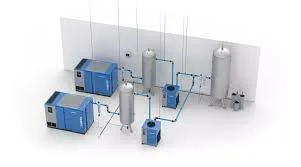Most of the industrial applications where compressed air is in use, would require pressure dew point (PDP) between +2° to +8° Celsius. For, all such applications, refrigerated type of air dryer can guarantee best performance. For pneumatic applications, pressure dew point should be considered over an atmospheric dew point as it will ensure desired level of the water content in compressed air which will be harmless to the process.
Very few industrial applications demand a quality of compressed air with PDP below +2° Celsius e.g., cryogenic applications or manufacturing process of hydroscopic materials. For such applications, it is recommended to install a refrigerated air dryer along with a suitable desiccant dryer for reducing overall investment as well as to minimize the purge-loss of desiccant dryer.
It is necessary to remove moisture from compressed air before it enters process machinery for preventing corrosion, rust, pollutants, and germs in your system, while ensuring the quality standards required for your industry as well as minimizing the wear & tear of your process equipment. Refrigerated dryer will increase the overall efficiency of process machinery and pneumatic tools.
Refrigerated dryer is used for removing the moisture and water vapour from compressed air. They are usually an economic solution and are most suitable for safeguarding your process requirements and extending the life of the system. Latest refrigerated dryers have an inbuilt PDP indicator.
How a refrigerated dryer protects equipment?
Refrigerated dryer works on the principle of cooling the compressed air to remove moisture. The heat generated by compression causes the moisture in the air to vaporise. The water vapour condenses into liquid when the air is cooled by a refrigerated dryer. Condensate is then removed from compressed air before entering the process. Your process equipment may corrode, rust and run inefficiently if the moisture is not removed from compressed air. This way, risk of corrosion and contamination is avoided along with increasing overall efficiency of the system by removing the moisture from compressed air.
Operating a refrigerated dryer
Refrigerated dryer resemble a house-fridge largely in its operation. Eco-friendly refrigerants are used for cooling the hot compressed air.
Refrigerated dryer consists of air-to-air heat exchanger, air-to-refrigerant heat exchanger, close-loop refrigeration cycle and a condensate drain system.
- Incoming hot compressed air is partially cooled by an out-going cold compressed air leaving the dryer.
- At the same time, the out-going compressed air is re-heated around the room temperature, so condensation does not form on the outside of the piping after dryer.
- Cooling of incoming air results in reducing the energy required by the refrigerant compressor and hence ensure further power saving.
- Incoming air is further cooled down to required PDP level at air-to-refrigerant exchanger by eco-friendly refrigerant.
- Water vapour in compressed air is condensed and is drained through an automatic condensate system.
- Hot refrigerant again is passed through close-loop refrigeration cycle for transforming into a cold refrigerant required for next cycle. The equipment is quite simple in construction and easy to operate. The maintenance and operation too is as easy as that of a house-fridge.
In some models, you’ll find features like intelligent drain discharge. This part eliminates condensate using electronic sensors, saving compressed air. Additionally, there are features to lower operational costs along with optional filtering system.
The compressed air’s relative humidity needs to be under 50% to be effective. There are optional PDP indicators that can help you keep track of the drying process. These gadgets measure dew point, show fan condition, and have a PDP alarm.
Despite this, installing and maintaining a refrigerator drier is rather easy. To reduce operational costs as much as possible, we built machines that are durable and simple to operate.
Non-cycling
Both non-cycling and cycling variants of refrigerator dryers are available in market. Cyclic dryer control dew point by switching on and off refrigeration cycle, hence PDP of system will be maintained in range of ± 5°C. Whereas non-cyclic dryer controls the dew point continuously guaranteeing the constant dew point. Non-cyclic dryer is energy efficient as it varies cooling depending upon air demand unlike over-running in case of cyclic dryers.
No matter whatever is variation in air demand, non-cyclic Mark dryer will maintain an exact PDP at lowest energy. The equipment is simple, safe and reliable.
Environmentally friendly gases
CFC content in refrigerant gases affect the environment. If the ozone layer is something that worries you, our MDS dryer uses environmentally safe R513A, R410A and R452A gas.
Proper drainage
You must utilise an oil-water separator at discharge if your refrigerated dryer is attached to an air compressor that uses oil injection. It’s crucial to properly dispose of oil, especially when awareness on environmental safety concerns is a universal problem.
Additionally, when getting rid of condensate, you should implement with a caution. Oil is frequently present in the condensate water that is released from a compressed air. Residual oil traces are so minute that can’t be seen with a naked eye; hence it is crucial to adhere to strict protocol.
Never pour contaminated condensate onto the ground or into a plastic container. It is advisable to make sure that you are adhering to proper regulations following strict EMS guidelines.
Choosing a refrigerated dryer for your air compressor
It is important to select right capacity of refrigerated air dryer if your application is critical. The capacity of refrigerated dryer depends upon inlet compressed air temperature, pressure of compressed air and compressor room temperature.
Our compressed air refrigerated dryers offer great dependability and are easy to install. When it comes to quality and protecting your process & compressed air equipment, these devices will add greater value.
You should think about installation, dependability, PDP, and high-quality parts when evaluating equipment. Finding the most energy-efficient option is also crucial.
Authored by; Mr. Kiran Panchal – Business Manager – Mark Compressors



